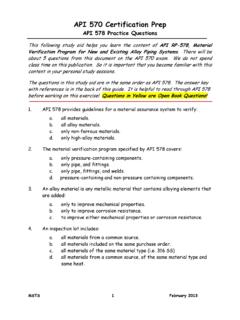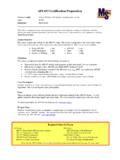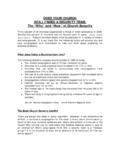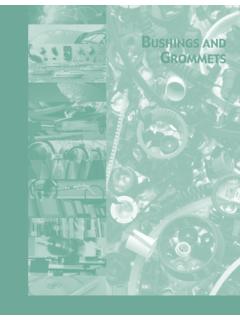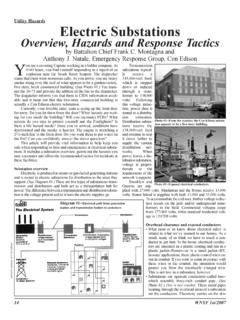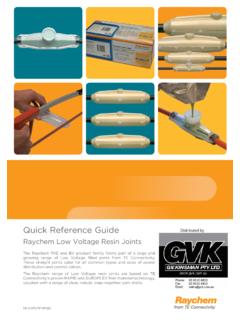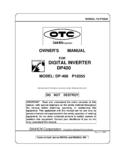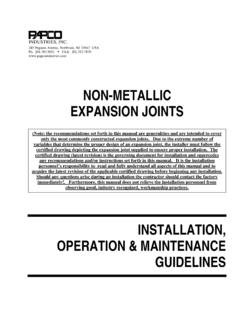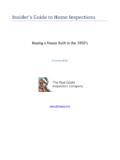Transcription of API 572 Study Guide - MSTS Training
1 API 572 Study Guide Practice Questions MSTS 1 August 2018 This Study aid will help you learn the content of API 572, Inspection of Pressure Vessels. There will be about 10 questions from API 572 on the API 510 exam. We do NOT spend time in class on this publication. So you become familiar with this content in your personal Study sessions. Here s some suggestion on working with this Study Guide . 1. Make a copy Always have a fresh copy when you repeat any Guide or homework. 2. Don t eat this Elephant at one time. The questions in this Study Guide are in the same order as the content written in API 572.
2 So .. read a few pages in API 572 and then answer the questions associated with those pages. Always put a MARK by the questions that you have to GUESS. 3. Check your answers. The Answer Key is provided in the back of this Guide with API 572 references. 4. For questions that you either MISS or GUESS, look up the answer in API 572. 5. If you have more time, repeat the process; Read a few more pages and Answer a few more questions. 6. Don t overlook short periods of time. Even 15 minutes is enough time to eat through 5-10 pages of API 572 and complete the associated questions. 7. Note! Questions that are YELLOW are considered Open Book Questions.
3 How many times should you do this Study Guide ? Keep repeating this Guide until you can score 80+%!!! And then .. occasionally repeat to maintain your peak score. JJ API 572 Study Guide Practice Questions MSTS 2 August 2018 Chapter 3 (pg 1-5) 1. An alteration is defined as: a) a physical change. b) restoring the vessel to original conditions. c) restoring the vessel to a safe suitable condition. d) changing either the design pressure or design temperature. 2. An examination point is circular area with a diameter not greater than: a) inch. b) inch. c) inches. d) inches. 3. The MAWP of a vessel is the maximum pressure permitted: a) anywhere on a vessel.
4 B) at top of the vessel. c) at the mid-point of the vessel. d) at the bottom of the vessel. 4. A repair is defined as: a) a physical change. b) restoring the vessel to original conditions. c) restoring the vessel to a safe suitable condition. d) changing either the design pressure or design temperature. 5. Temper embrittlement can occur in: a) carbon steels. b) low alloy steels. c) carbon or low alloy steels. d) austenitic stainless steels. 6. Temper embrittlement occurs in some materials with: a) short-term exposures above 650oF. b) long-term exposures above 650oF. c) short-term exposures above 1100oF.
5 D) long-term exposures above 1100oF. API 572 Study Guide Practice Questions MSTS 3 August 2018 Chapter 4 (pg 6-14) 1. Most pressure vessels codes do not apply to vessels with internal or external pressure that is less than: a) 5 psig. b) 15 psig. c) 25 psig. d) 50 psig. 2. Many vessels with external pressure are: a) jacketed. b) accumulators. c) reactors. d) regenerators. 3. Vessel shell rings are normally made by: a) rolling plate at ambient temperatures. b) rolling plate at elevated temperatures. c) rolling plate at either elevated or ambient temperatures. d) forging. e) casting and machining.
6 4. When fabricating a vessel shell, which fabrication method does not result in a longitudinal shell weld? a) Extruding b) Hot forging c) Multi-layer d) Rolling 5. Shells constructed with multi-layers (a number of thin cylindrical sections) are normally used for vessels having: a) high design pressures. b) high design temperatures. c) exotic materials. d) a small diameter. 6. Which the most common material used to make pressure vessels? a) Carbon steel b) Chrome c) Ferritic stainless steel d) Nickle alloys API 572 Study Guide Practice Questions MSTS 4 August 2018 7. Which of the following materials is seldom used to make a pressure vessel but is common in heat exchanger tubes?
7 A) Aluminum alloys b) Copper alloys c) Magnesium alloys d) Zinc alloys 8. Cooling water tubes are often made of steel or: a) aluminum alloys. b) austenitic stainless steel. c) copper alloys. d) zinc alloys. 9. Titanium tubes are often found in which of the following processes? a) Crude oil above 650 oF. b) Erosive services c) Processes subject to HTHA d) Seawater 10. What is the primary purpose for installing a metallic liner on the inside of a vessel? a) Decrease friction and improve fluid flow b) Improve heat transfer c) Minimize the effort to clean vessel at next outage d) Resist corrosion 11. When are pressure vessel shells & heads normally made from a solid alloy material?
8 (one without cladding) a) In corrosive service b) Service where high product purity is needed c) High operating temperatures d) High operating pressures e) Either high operating temperatures or high operating pressures 12. Which of the following is not a way metallic liners are attached to the base metal? a) Explosion bonded b) Rolled with based metal c) Pressurized d) Welding API 572 Study Guide Practice Questions MSTS 5 August 2018 13. Refractory is often attached to a vessel shell with: a) cement adhesive. b) hex mesh. c) rebar. d) stainless steel tabs. 14. What are two primary reasons for the use of non-metallic liners?
9 A) Resist erosion, and insulate to reduce shell temperature b) Insulate to reduce shell temperature, and resist thermal expansion c) Resist corrosion, and resist thermal expansion d) Resist stress corrosion cracking, and insulate to reduce shell temperature e) Beautify the facility, and improve rate of heat transfer 15. Non-metallic vessels are sometimes used in: a) corrosive services. b) high-temperature services. c) high-pressure services. d) low-temperature services. 16. Which of the following non-metallic materials is sometimes used to build vessels in corrosive services? a) CPVC b) FRP c) PVC d) Refractory 17.
10 A vessel that operates with a vacuum will often have: a) hemispherical heads. b) internal braces. c) refractory lining. d) stiffening rings. 18. An optionally part of an exchanger that is used to protect the tubes at the inlet nozzle is called a(n): a) baffle. b) demister mat. c) impingement plate. d) strip lining. API 572 Study Guide Practice Questions MSTS 6 August 2018 19. The vessel fabrication code called the API/ASME Code for Unfired Pressure Vessels was discontinued in: a) 1939. b) 1956. c) 1973. d) 1980. 20. Most pressure vessels in USA refineries are constructed to: a) API/ASME Code. b) ASME B&PV Code Section VIII Div 1.
